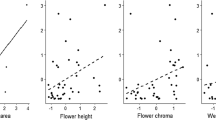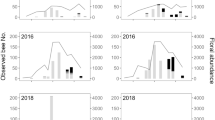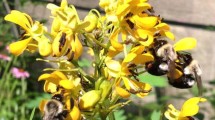Abstract
Floral constancy of foraging bees influences plant reproduction. Constancy as observed in nature arises from at least four distinct mechanisms frequently confounded in the literature: context-independent preferences for particular plant species, preferential visitation to the same species as the previous plant visited (simple constancy), the spatial arrangement of plants, and the relative abundances of co-flowering species. To disentangle these mechanisms, we followed individual bee flight paths within patches where all flowering plants were mapped, and we used step selection models to estimate how each mechanism influences the probability of selecting any particular plant given the available plants in a multi-species community. We found that simple constancy was positive: bees preferred to visit the same species sequentially. In addition, bees preferred to travel short distances and maintain their direction of travel between plants. After accounting for distance, we found no significant effect of site-level plant relative abundances on bee foraging choices. To explore the importance of the spatial arrangement of plants for bee foraging choices, we compared our full model containing all parameters to one with spatial arrangement removed. Due to bees’ tendency to select nearby plants, combined with strong intraspecific plant clumping, spatial arrangement was responsible for about 50% of the total observed constancy. Our results suggest that floral constancy may be overestimated in studies that do not account for the spatial arrangement of plants, especially in systems with intraspecific plant clumping. Plant spatial patterns at within-site scales are important for pollinator foraging behavior and pollination success.





Similar content being viewed by others
Availability of data and material
The data were deposited in the figshare repository under the reference number https://doi.org/10.6084/m9.figshare.14732760.
Code availability
Not applicable.
References
Akaike H (1974) A new look at the statistical model identification. IEEE Trans Autom Control 19:716–723. https://doi.org/10.1109/TAC.1974.1100705
Arthur SM, Manly BFJ, McDonald LL, Garner GW (1996) Assessing habitat selection when availability changes. Ecology 77:215–227. https://doi.org/10.2307/2265671
Ascher JS, Pickering J (2015) Discover life bee species guide and world checklist (Hymenoptera: Apoidea: Anthophila). Accessed 20 March, 2018 from <http://www.discoverlife.org/mp/20q?guide=Apoidea_species>
Avgar T, Potts JR, Lewis MA, Boyce MS (2016) Integrated step selection analysis: bridging the gap between resource selection and animal movement. Methods Ecol Evol 7:619–630. https://doi.org/10.1111/2041-210X.12528
Baddeley A, Turner R (2005) spatstat: an R package for analyzing spatial point patterns. J Stat Softw 12:1–42
Baddeley A, Rubak E, Turner R (2016) Spatial Point patterns: methodology and applications in R. CRC Press, Taylor & Francis Group, Boca Raton, FL
Bagchi R, Swamy V, Farfan J-PL, Terborgh J, Vela CIA, Pitman NCA, Sanchez WG (2018) Defaunation increases the spatial clustering of lowland Western Amazonian tree communities. J Ecol 106:1470–1482. https://doi.org/10.1111/1365-2745.12929
Brosi BJ, Briggs HM (2013) Single pollinator species losses reduce floral fidelity and plant reproductive function. PNAS 110:13044–13048. https://doi.org/10.1073/pnas.1307438110
Bruninga-Socolar B, Crone EE, Winfree R (2016) The role of floral density in determining bee foraging behavior: a natural experiment. Nat Areas J 36:392–399. https://doi.org/10.3375/043.036.0406
Chittka L, Gumbert A, Kunze J (1997) Foraging dynamics of bumble bees: correlates of movement within and between plant species. Behav Ecol 8:239–249. https://doi.org/10.1093/beheco/8.3.239
Chittka L, Thomson JD, Waser NM (1999) Flower constancy, insect psychology, and plant evolution. Naturwissenschaften 86:361–377. https://doi.org/10.1007/s001140050636
Chudzinska M, Dupont YL, Nabe-Nielsen J, Maia KP, Henriksen MV, Rasmussen C, Kissling WD, Hagen M, Trøjelsgaard K (2020) Combining the strengths of agent-based modelling and network statistics to understand animal movement and interactions with resources: example from within-patch foraging decisions of bumblebees. Ecol Model 430:109119. https://doi.org/10.1016/j.ecolmodel.2020.109119
Cresswell JE (1997) Spatial heterogeneity, pollinator behaviour and pollinator-mediated gene flow: bumblebee movements in variously aggregated rows of oil-seed rape. Oikos 78:546–556. https://doi.org/10.2307/3545616
Cresswell JE, Bassom AP, Bell SA, Collins SJ, Kelly TB (1995) Predicted pollen dispersal by honey-bees and three species of bumble-bees foraging on oil-seed rape: a comparison of three models. Funct Ecol 9:829–841. https://doi.org/10.2307/2389980
Crone EE (2013) Responses of social and solitary bees to pulsed floral resources. Am Nat 182:465–473. https://doi.org/10.1086/671999
Crone EE, Lesica P (2006) Pollen and water limitation in Astragalus scaphoides, a plant that flowers in alternate years. Oecologia 150:40–49. https://doi.org/10.1007/s00442-006-0506-0
Crone EE, Miller E, Sala A (2009) How do plants know when other plants are flowering? Resource depletion, pollen-limitation and mast-seeding in a perennial wildflower. Ecol Lett 12:1119–1126. https://doi.org/10.1111/j.1461-0248.2009.01365.x
Dauber J, Biesmeijer JC, Gabriel D, Kunin WE, Lamborn E, Meyer B, Nielsen A, Potts SG, Roberts SPM, Sõber V, Settele J, Steffan-Dewenter I, Stout JC, Teder T, Tscheulin T, Vivarelli D, Petanidou T (2010) Effects of patch size and density on flower visitation and seed set of wild plants: a pan-European approach. J Ecol 98:188–196. https://doi.org/10.1111/j.1365-2745.2009.01590.x
Fortin D, Beyer HL, Boyce MS, Smith DW, Duchesne T, Mao JS (2005) Wolves influence elk movements: behavior shapes a trophic cascade in Yellowstone National Park. Ecology 86:1320–1330. https://doi.org/10.1890/04-0953
Fox J, Weisberg S (2019) An R companion to applied regression, 3rd edn. Sage Publications, USA
Fründ J, Dormann CF, Holzschuh A, Tscharntke T (2013) Bee diversity effects on pollination depend on functional complementarity and niche shifts. Ecology 94:2042–2054. https://doi.org/10.1890/12-1620.1
García D, Houle G (2005) Fine-scale spatial patterns of recruitment in red oak (Quercus rubra): what matters most, abiotic or biotic factors? Écoscience 12:223–235. https://doi.org/10.2980/i1195-6860-12-2-223.1
Gegear RJ, Thomson JD (2004) Does the flower constancy of bumble bees reflect foraging economics? Ethology 110:793–805. https://doi.org/10.1111/j.1439-0310.2004.01010.x
Ghazoul J (2006) Floral diversity and the facilitation of pollination. Ecology 94:295–304. https://doi.org/10.1111/j.1365-2745.2006.01098.x
Grüter C, Ratnieks FLW (2011) Flower constancy in insect pollinators: adaptive foraging behavior or cognitive limitation? Commund Integr Biolo 4:633–636. https://doi.org/10.4161/cib.16972
Harmon-Threatt AN, de Valpine P, Kremen C (2017) Estimating resource preferences of a native bumblebee: the effects of availability and use–availability models on preference estimates. Oikos 126:633–641. https://doi.org/10.1111/oik.03550
Hill PSM, Hollis J, Wells H (2001) Foraging decisions in nectarivores: unexpected interactions between flower constancy and energetic rewards. Anim Behav 62:729–737. https://doi.org/10.1006/anbe.2001.1775
Internicola AI, Page PA, Bernasconi G, Gigord LDB (2007) Competition for pollinator visitation between deceptive and rewarding artificial inflorescences: an experimental test of the effects of floral colour similarity and spatial mingling. Funct Ecol 21:864–872. https://doi.org/10.1111/j.1365-2435.2007.01303.x
Ishii HS (2005) Analysis of bumblebee visitation sequences within single bouts: implication of the overstrike effect on short-term memory. Behav Ecol Sociobiol 57:599–610. https://doi.org/10.1007/s00265-004-0889-z
Ishii HS, Masuda H (2014) Effect of flower visual angle on flower constancy: a test of the search image hypothesis. Behav Ecol 25:933–944. https://doi.org/10.1093/beheco/aru071
Karron JD, Holmquist KG, Flanagan RJ, Mitchell RJ (2009) Pollinator visitation patterns strongly influence among-flower variation in selfing rate. Ann Bot 103:1379–1383. https://doi.org/10.1093/aob/mcp030
Katz E, Essenberg CJ (2018) The effect of the dispersion of rewarding and rewardless flowers on visitation and constancy by bumblebees (Bombus impatiens). Journal of Pollination Ecology 23:119–126. https://doi.org/10.26786/1920-7603(2018)14
Keasar T (2000) The spatial distribution of nonrewarding artificial flowers affects pollinator attraction. Anim Behav 60:639–646. https://doi.org/10.1006/anbe.2000.1484
Knight TM, Ashman T-L, Bennett JM, Burns JH, Passonneau S, Steets JA (2018) Reflections on, and visions for, the changing field of pollination ecology. Ecol Lett 21:1282–1295. https://doi.org/10.1111/ele.13094
Koch J, Strange J, Williams P (2011) Bumble bees of the Western United States. USDA Forest Service and the Pollinator Partnership, Washington, DC and San Francisco CA
Kunin WE (1993) Sex and the single mustard: population density and pollinator behavior effects on seed-set. Ecology 74:2145–2160. https://doi.org/10.2307/1940859
Lenth R (2020) emmeans: estimated marginal means, aka least-squares means. R package version 1.5.1. https://CRAN.R-project.org/package=emmeans
Lesica P, Cooper SV (1997) Presettlement vegetation of southern Beaverhead County Montana. Unpublished report to the State Office, Bureau of land management and Beaverhead-Deerlodge National Forest. Montana Natural Heritage Program, Helena, MT
Lihoreau M, Chittka L, Raine NE (2011) Trade-off between travel distance and prioritization of high-reward sites in traplining bumblebees. Funct Ecol 25:1284–1292. https://doi.org/10.1111/j.1365-2435.2011.01881.x
Lihoreau M, Chittka L, Le Comber SC, Raine NE (2012) Bees do not use nearest-neighbour rules for optimization of multi-location routes. Biol Let 8:13–16. https://doi.org/10.1098/rsbl.2011.0661
MacArthur RH, Pianka ER (1966) On optimal use of a patchy environment. Am Nat 100:603–609. https://doi.org/10.1086/282454
Maestre FT (2006) Linking the spatial patterns of organisms and abiotic factors to ecosystem function and management: Insights from semi-arid environments. Web Ecol 6:75–87. https://doi.org/10.5194/we-6-75-2006
Manly BFJ, McDonald LL, Thomas DL, McDonald TL, Erickson WP (2002) Resource selection by animals: statistical design and analysis for field studies. Kluwer Academic Publishers, Dordrecht, The Netherlands
Michener CD (2000) The bees of the world. The Johns Hopkins University Press, Baltimore, MD
Morris WF (1993) Predicting the consequence of plant spacing and biased movement for pollen dispersal by honey bees. Ecology 74:493–500. https://doi.org/10.2307/1939310
Ollerton J, Winfree R, Tarrant S (2011) How many flowering plants are pollinated by animals? Oikos 120:321–326. https://doi.org/10.1111/j.1600-0706.2010.18644.x
Plowright RC, Galen C (1985) Landmarks or obstacles: the effects of spatial heterogeneity on bumble bee foraging behavior. Oikos 44:459–464. https://doi.org/10.2307/3565787
R Core Team (2018) R: a language and environment for statistical computing. R Foundation for Statistical Computing, Vienna, Austria. URL https://www.R-project.org/
R Core Team (2020) R: a language and environment for statistical computing. R Foundation for Statistical Computing, Vienna, Austria. URL https://www.R-project.org/
Richards SA, Williams NM, Harder LD (2009) Variation in pollination: causes and consequences for plant reproduction. Am Nat 174:382–398. https://doi.org/10.1086/603626
Schroeder JW, Dobson A, Mangan SA, Petticord DF, Herre EA (2020) Mutualist and pathogen traits interact to affect plant community structure in a spatially explicit model. Nat Commun 11:1–10. https://doi.org/10.1038/s41467-020-16047-5
Tenhumberg B, Crone EE, Ramula S, Tyre AJ (2018) Time-lagged effects of weather on plant demography: drought and Astragalus scaphoides. Ecology 99:915–925. https://doi.org/10.1002/ecy.2163
Terborgh J, Pitman N, Silman M, Schichter H, Núñez P (2002) Maintenance of tree diversity in tropical forests. In: Levey DJ, Silva WR, Galetti M (eds) Seed dispersal and frugivory: ecology, evolution and conservation. CABI Publishing, New York, NY, pp 1–18
Therneau T (2015) A package for survival analysis in S. version 2.38. https://CRAN.R-project.org/package=survival.
Thurfjell H, Ciuti S, Boyce MS (2014) Applications of step-selection functions in ecology and conservation. Mov Ecol 2:4. https://doi.org/10.1186/2051-3933-2-4
Turchin P (2015) Quantitative analysis of movement: measuring and modeling population redistribution in animals and plants. Beresta Books, USA
Waser NM (1986) Flower constancy: definition, cause, and measurement. Am Nat 127:593–603. https://doi.org/10.1086/284507
Wells H, Wells PH (1983) Honey bee foraging ecology: optimal diet, minimal uncertainty or individual constancy? J Anim Ecol 52:829–836. https://doi.org/10.2307/4457
Winfree R, Williams NM, Dushoff J, Kremen C (2007) Native bees provide insurance against ongoing honey bee losses. Ecol Lett 10:1105–1113. https://doi.org/10.1111/j.1461-0248.2007.01110.x
Acknowledgements
We thank Tina Harrison, James Reilly, Michael Roswell, Colleen Smith, and Jacob Socolar for constructive comments on drafts of this manuscript. Tiffany Bennett and Jacob Socolar provided welcome assistance in the field. We are grateful to the Handling Editor and two peer reviewers for their thoughtful comments, which greatly improved this paper.
Funding
This research was funded by numerous grants to BBS in support of graduate student research from the Rutgers University School of Environmental and Biological Sciences and the Rutgers University Ecology and Evolution Graduate Program. Field research was partly supported by NSF 10–20889 to EEC.
Author information
Authors and Affiliations
Contributions
BBS, RW, and EEC conceived and designed the field study and BBS collected all data. BBS and EEC analyzed the data. BBS wrote the manuscript with intellectual and editorial contributions from RW and EEC.
Corresponding author
Ethics declarations
Conflict of interest
The authors have no conflicts of interest to report.
Ethics approval
Not applicable.
Consent to participate
Not applicable.
Consent for publication
All the authors approve this manuscript for submission to Oecologia. It has not been submitted elsewhere.
Additional information
Communicated by Jessica Forrest.
Supplementary Information
Below is the link to the electronic supplementary material.
Rights and permissions
About this article
Cite this article
Bruninga-Socolar, B., Winfree, R. & Crone, E.E. The contribution of plant spatial arrangement to bumble bee flower constancy. Oecologia 198, 471–481 (2022). https://doi.org/10.1007/s00442-022-05114-x
Received:
Accepted:
Published:
Issue Date:
DOI: https://doi.org/10.1007/s00442-022-05114-x




